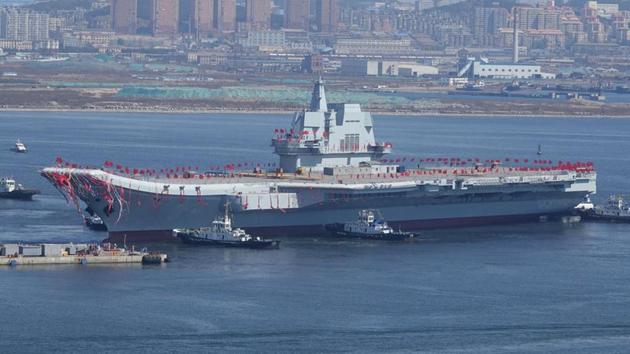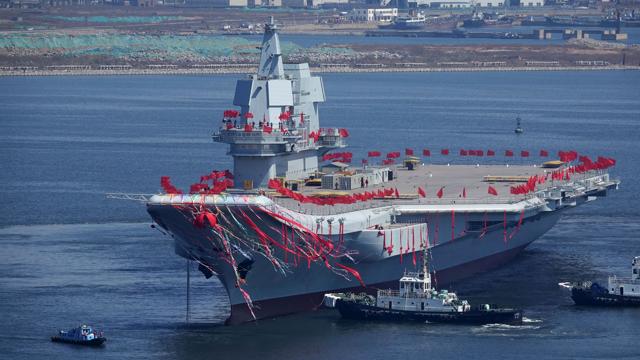China’s home-grown aircraft carrier boosts naval power
China has launched its first home-grown aircraft carrier, which is expected to enter service in 2020 after several years of sea trials.
China on Wednesday launched its first domestically built aircraft carrier in the northeastern port city of Dalian against the backdrop of maritime disputes in the South China Sea and unease in New Delhi over Beijing’s increasing naval prowess.

The People’s Liberation Army Navy began building the 70,000-tonne aircraft carrier in November 2013 and it is China’s second carrier. The first to be inducted was the Liaoning, a refurbished Soviet Union-made vessel commissioned in 2012.
The unnamed Type 001A vessel, decorated with red flags and ribbons, was transferred from a dry dock into the water after a ribbon was cut and a champagne bottle was broken on its bow as steam whistles from nearby ships went off.
Gen Fan Changlong, vice-chairman of the Central Military Commission that is headed by President Xi Jinping, joined the launch ceremony.
Fan’s presence, state media said, indicated “the significance Chinese leaders attach to the colossal ship because only the most important equipment for the PLA would have top-level officers at the public debut ceremony”.
Construction of the new carrier began in November 2013 and experts believe it is likely to enter service around 2020, after several years of sea trials and testing of weapons and other systems.
“The main body of the carrier has been completed, with equipment of major systems including propulsion and electricity installed,” state-run Xinhua news agency reported.
“In the next phase, the carrier will start the outfitting process,” state-controlled China Daily quoted a military statement as saying. “During the outfitting stage, engineers and workers will complete the installation of the ship’s power plant, engines, interior equipment and systems as well as weapons.”

In Beijing, Ma Xiaoguang, a Chinese mainland spokesperson with the Taiwan Affairs Office of the State Council, said: “(The move) will help to strengthen our capability to safeguard national sovereignty, territorial integrity, as well as major and core interests.”
Military expert Wang Xiaoxuan wrote for the China Daily: “A domestically built aircraft carrier indeed marks a very important step for China toward boosting its naval combat capability and helping safeguard its national interests across the oceans. Aircraft carriers are an important, and in these times a necessary, component of a country’s navy.”
Wang added, “China’s military budget is only 1.28% of its GDP, of which only 10% is spent on the navy, which is low compared with that of the US, Russia and India. China is developing aircraft carriers for defence purposes; it has no intention of challenging other countries.”
Wang’s arguments might take some convincing.
Earlier this year, China’s aircraft carrier group led by the Liaoning and comprising several destroyers and J-15 carrier-based combats jets and helicopters, sailed through Bohai Sea, Yellow Sea, East China Sea and South China Sea, maritime regions where Beijing is involved in disputes.
The formation also passed through the Miyakato, Bashi and Taiwan straits, according to the Chinese navy.
The launch of the aircraft carrier and China’s efforts to ramp up the capabilities of its navy will be closely watched by India, which is currently building its first home-grown carrier, the Vikrant.
The Vikrant is much smaller at 40,000 tonnes, meaning it will be able to carry fewer jets and helicopters. Work in it began at the Cochin Shipyard in 2009 and the carrier was launched from dry dock in 2011 but it is unlikely to be completed before 2023, about three years after the Chinese vessel.
India currently has only one active aircraft carrier, INS Vikramaditya, which was purchased second hand from Russia and refurbished
“Beside China, six countries operate a total of 16 aircraft carriers. The US is the largest operator as it now runs 10 Nimitz-class nuclear-powered carriers with each having a full-load displacement of about 100,000 tons,” state media reported.



